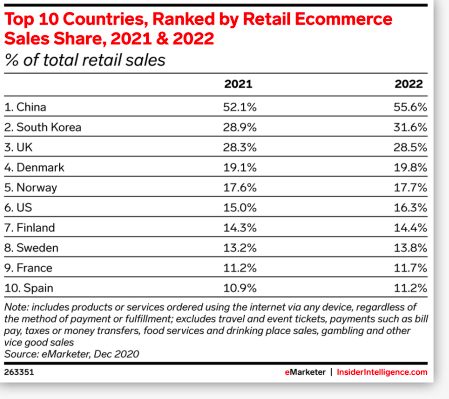If you work for or with brands, one realizes fast that these businesses are in trouble. The amount of brands that have their business in tune is akin to finding chicken teeth. Small, medium, or large companies have blind spots that they might not know about, impacting their survival. Whether it’s called digital transformation, digitization may provide the enormous opportunity available of our lifetime.
Marc Andreessen famously wrote that software is eating the world. The reality is the use of legacy technology, unclear business models, unwillingness to use technology leads to inefficiency, unprofitability, and irrelevance.

How does digitization help commerce?
If we move more things online – customers can access a more extensive selection. Businesses can access a new set of consumers who are unable to find what they want to buy. I live in a country (South Africa) with one percent of e-commerce penetration compared to retail. Imagine if more stores are online and more consumers can buy items from different market participants – competition occurs. The market decides which brands and businesses succeed, not those who are better funded.

While developed e-commerce markets like the UK and the United States have e-commerce penetration of less than 30%, retail is still larger than e-commerce. According to eMarketer. by the end of 2021, more than 52% of retail in China will be online. China is the exception and shows us the future.
China has accelerated e-commerce adoption due to its customers using universal apps such as Alibaba’s Taobao, Tencent’s WeChat, and, more recently, Bytedance’s Douyin. E-commerce leapfrogged retail due to underdeveloped infrastructure and accessibility to economic bandwidth on mobile devices.
Retailers can operate better
I have worked with retailers, and it has always felt like businesses are unwilling to leverage technology more optimal. Yes, you read that right. Stock-outs seen in stores are a reality as ordering and keeping products on the shelf is hard.
A simple thing such as changing a price on a shelf is akin to rocket science. It’s not centralized and requires a staff member to stick a new barcode with a price on a shelf. The points of failure increase with every opportunity for communication.
Retail locations are by enlarge unprofitable as similar SKUs are at every place to provide consumers with a similar experience. As no data collection is active, consumers are sometimes required to drive to another store or wait to deliver that item (admit it – we all have experienced this). Stock can sit on shelves as it might not be relevant to a location. Imagine if every product in a store is purchased – it seems logical but is not a given. Higher rent costs occur as larger stores showcase 10k SKUs. It’s a vicious inefficient cycle seen in most developed retail markets.
Opening new store locations is not a moat nor a competitive advantage but rather a sign of inefficiency.
One of my most significant frustration points with retailers in South Africa is the consistent re-location of items. The peanut butter was on aisle four and now is at aisle seven. The point is to have the consumer walk around the store and have the moment of inspiration to buy something that was not the intended reason for the shopping trip.
Store owners charge brands to be on eye level on shelves but have no analytics to prove that consumers saw items. If you operate an online store, the amount of analytics available to make decisions on is extensive.
Customer benefits
Digitization enables customers to interact with brands, whether via stores such as Intime or marketplaces such as Tmall. Having shopped in Amazon stores in Seattle, it still felt unnatural as delivery trucks and boxes are scattered all over the city.
One of the largest pain points for consumers and retailers is the payment process. Customers have to wait for their turn for a teller; then, all the items are scanned and packed. I recognize that self-checkout is a massive loss leader.
Imagine if consumers could scan their items via their phone and then pack it themselves. Having seen this in China, one realizes that this should be normal as the phone becomes a central point of interaction between the customer, the store, and the brands.
One of the reasons Super apps are so compelling is the repeat usage of different parts of the app by consumers. These apps can use locality as a moat and drive efficiencies of scale by offering customers what they want when they want it.
Why are retailers not using mobile web marketing when I walk into the store? Why are stores not marketing to consumers close by instead of using catalogs which are inefficient? In an on-demand world, customers want information about when my delivery is due, where the product in the store, etc. Yet, legacy technology is unable to assist.
The Digitization need
I am seeing the need for software to assist brands and retailers to become closer to consumers. Why can’t legacy supply chains be integrated with platforms such as Shopify easily? Why can’t engagement occur throughout the entire purchase path with notifications? Why does product information need many meetings instead of a simple connector to draw the data from ERP or OMS platforms?
I keep hearing that Shopify is the solution to all e-commerce problems, but how does a brand with over 1000 products with multiple variants and sizes get their goods online?
The conclusion
Investors should be looking at startups that can leverage legacy software to do the basics, such as product uploads, stock levels, purchase orders, etc. These things are almost always not mentioned in press releases, but for commerce to grow with a CAGR of more than 10% worldwide, we need better software.
Brands, you have no more excuses – even if you were bankrupt, the basics would start the turnaround. Can we also be more realistic about turn arounds – millions in whatever currency in year one is just crazy.
I repeat, digitization is the largest opportunity of our time – where are your bets being made for the future?
